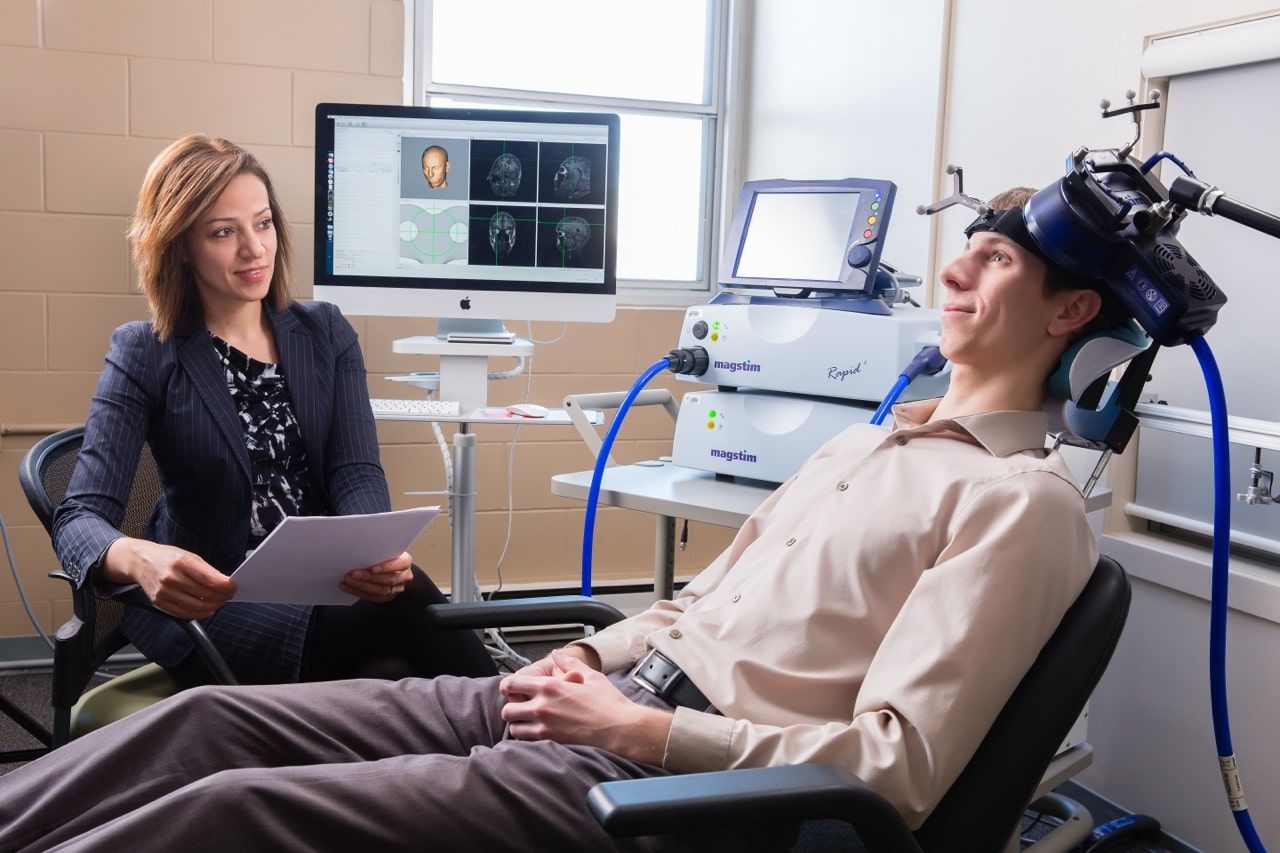How Long Does TMS Last? What to Expect for Results and Duration
If you’re considering Transcranial Magnetic Stimulation (TMS) for depression, you’re probably wondering: How long do the results actually last? This evidence-based guide uses academic research and peer-reviewed studies to help you answer that question. We’ll explore what to expect, from how soon you might start feeling better, to how long improvements can last, when maintenance… Read more

Reviewed by Amanda MacLeod, PA-C
Staff Provider at PsychPlus
August 12, 2025

If you’re considering Transcranial Magnetic Stimulation (TMS) for depression, you’re probably wondering: How long do the results actually last? This evidence-based guide uses academic research and peer-reviewed studies to help you answer that question. We’ll explore what to expect, from how soon you might start feeling better, to how long improvements can last, when maintenance treatment might be needed, and what factors influence long-term success, especially for adults with treatment-resistant depression (TRD).
Disclaimer: This content is for informational purposes only and is not a substitute for professional medical advice. Always consult a licensed healthcare provider before making treatment decisions.
What is TMS? Understanding TMS and the Research
Transcranial Magnetic Stimulation (TMS) is an FDA-approved, non-invasive neuromodulation treatment for adults with major depressive disorder (MDD) who have not received adequate relief from antidepressant medications or psychotherapy. TMS delivers focused magnetic pulses to stimulate specific areas of the brain involved in mood regulation, most commonly the left dorsolateral prefrontal cortex (DLPFC), which plays a key role in executive function and emotional control, as well as its downstream connections, such as the anterior cingulate cortex (ACC), a region involved in mood processing and treatment response.
TMS was first approved by the FDA for depression in 2008, with more recent approvals for obsessive-compulsive disorder (OCD) in 2017 and older adolescent populations in 2024. It continues to be studied for many other neuropsychiatric conditions, including post-traumatic stress disorder (PTSD), anxiety, and substance use disorders [2].
TMS is also increasingly recognized as a promising treatment for patients with co-occurring depression and chronic pain, given the overlap in dysregulated neurobiological pathways and shared brain regions (DLPFC and ACC). A review of 36 studies involving 1,339 patients with both chronic pain and depression found that even with protocol variability, TMS was consistently safe and well-tolerated with minimal side effects. Further research is needed to develop standardized protocols to better understand and optimize TMS’s dual treatment potential for both chronic pain and mood disorders [8–9].
TMS is a well-established treatment option for chronic and severe depression, especially in treatment-resistant populations where medications and therapy have failed. Its current and expanding use is supported by a growing body of evidence demonstrating clinical effectiveness, with a consistently favorable safety profile and strong tolerability [1].
What to Expect with TMS? Process & Duration
A complete course of TMS typically lasts 6 weeks, consisting of 5 treatment sessions per week. The first visit is a “mapping” session that lasts about 30 minutes to determine personalized treatment parameters. Each treatment session lasts 20-40 minutes, depending on the protocols used. All treatments are performed on an outpatient basis, typically Monday through Friday, at a clinic. TMS is a non-invasive treatment that is neither a medication nor a surgical procedure, and is generally well-tolerated by most patients. Side effects are typically minimal and mild, and can include scalp discomfort or headache at the stimulation site. You are awake and alert, seated in a comfortable chair during treatment sessions.TMS does not require anesthesia, sedation, or recovery time. You can drive yourself to and from sessions and resume your normal activities after each session if desired [2].
A full course of TMS includes at least 30 treatment sessions, with most insurance plans initially approving 36 sessions. While this treatment length typically provides optimal results for most patients, the treatment sessions and duration can be further customized based on individual response and specific protocols. Those with long-standing, treatment-resistant depression, complex factors, or older age may benefit from extended treatment durations of 6-8 weeks or more to achieve the best results [3].
Minor scheduling disruptions do not significantly affect outcomes; however, you should expect to commit to 5 days of treatment per week for at least 6 weeks, as research shows TMS results are strongly based on this protocol consistency. If sessions are missed due to unexpected or urgent circumstances, you can reschedule any missed sessions at the end of treatment for the same total number of treatments. Some patients utilize FMLA for short-term leave during treatment sessions, while others might wait until their schedule is more available for TMS consistency. You can discuss these options further with your provider during the initial consultation and throughout treatment.
How Long Until TMS Works? Timeline & Results
Most patients begin to notice improvements within the first 2-4 weeks after starting TMS. Sometimes those around you (family, friends) might recognize changes before you do. Response is unique to each individual, but benefits typically include improved mood, sleep quality, energy, motivation, engagement in activities, and overall well-being [2]. Research, including findings from UCLA Health, suggests that early response to treatment may predict better long-term outcomes, especially when the full treatment course is completed [2, 4–7].
Most protocols recommend at least 30 to 36 sessions for optimal effect. While missing an occasional session doesn’t typically impair effectiveness, consistency improves outcomes [2]. Everyone responds to TMS differently and at their own pace, but the benefits from TMS progressively accumulate and strengthen throughout the entire treatment course. TMS treatment and protocols can also be adjusted based on response for improved outcomes and longevity.
It’s important to remember that progress during TMS is highly individualized. For most patients, improvements build subtly, with the most significant benefits often emerging midway or toward the end of treatment. Since the goal of TMS is lasting symptom relief, not just a quick fix, staying committed to the full treatment course is crucial for achieving the best long-term results.
How Long Does TMS Last? Longevity & Retreatment
The benefits and duration of Transcranial Magnetic Stimulation (TMS) vary across individuals; however, many patients experience sustained relief for 6-12 months following a complete course of TMS, and in some cases, even longer. An extensive, real-world, multisite study found that around 62% of initial responders maintained clinical improvement at one year, with most relapses occurring within the first 6 months post-treatment [10]. Another systematic review and meta-analysis of clinical trials found that 50–60% of patients consistently experienced meaningful symptom reduction for up to one year after the initial course of repetitive TMS [5].
Depression is most commonly a recurring condition with fluctuations throughout one’s life. TMS induces neuroplasticity to improve and strengthen positive neural pathways; however, our brains will continue to change and adapt to our environments over time. While TMS is not a permanent cure for depression, evidence supports its durability and repeatability as a treatment strategy. TMS can provide long-term symptom relief by improving and strengthening our brain’s natural pathways, especially in those with chronic and severe symptoms that have been difficult to treat and have not responded to traditional methods of medications and therapy.
‘Remission’ is a term used for symptoms that have resolved or are only minimal for a consistent period of time, at least 2 months for depression. ‘Relapse’ is a term used when symptoms return to a certain level after a period of remission, the return of moderate to severe symptoms in depression. If TMS was successful, maintenance treatments (1-2 sessions/month) can help prolong the benefits, and retreatment (repeating a full TMS course) can be utilized when symptoms return. Maintenance TMS sessions can help prolong benefits, but are not yet covered by most insurance plans, despite supporting research. Retreatment is currently covered by most insurances, but requires a documented history of successful TMS with improvements lasting at least 2-6 months before the return of depressive symptoms. Insurances approve a full TMS course for retreatment.
Patients who have a relapse of symptoms, especially after initial remission, respond well to retreatment with another full TMS course to restore remission, highlighting TMS’s use as an effective, repeatable intervention for symptom control and long-term management of treatment-resistant depression [6]. Maintenance TMS treatment can significantly prolong therapeutic gains and reduce the risk of relapse in specific individuals [4].
TMS response is unique to each individual, but benefits can be strengthened for most people to last longer with supportive measures, such as healthy lifestyle habits, therapy, and medications. Recent research also suggests that early responders and those with strong adherence and consistency in TMS treatment are more likely to experience a longer duration of benefits, with a less frequent need for maintenance or retreatment [5]. Long-term follow-ups also show sustained improvements in quality of life, daily functioning, and mood stability at 12 months among those who respond well initially [10].
Is TMS Right for You?
Transcranial Magnetic Stimulation (TMS) is FDA-approved for major depressive disorder (MDD) and obsessive-compulsive disorder (OCD), with a significant amount of ongoing research for many other neuropsychiatric conditions. TMS is strongly recommended and particularly effective for individuals with treatment-resistant depression (TRD), where medications and therapy have not provided adequate relief. TMS is also a good treatment option for reducing medication burden, especially for those with multiple comorbidities, medications, or side-effect concerns [14-15]. Some people are able to reduce or discontinue some of their medications after 6-12 months of sustained remission and under the guidance of a psychiatric provider, while most finally achieve adequate relief with their current medications and continued treatment plan.
TMS is covered by most insurances for severe depression with documentation of symptoms and previously failed treatment attempts. Self-pay is always an option for any treatment, and allows for additional treatments and newer evidence-based indications or protocols (eg, SAINT) that are not covered by insurance.
TMS is an excellent, non-invasive treatment option, with 20-40 minute sessions, and the ability to return to daily activities immediately afterwards without requiring recovery time. Response varies with each individual, but benefits accumulate throughout treatment, and adjustments can be made to achieve better results and duration. Although treatment sessions are held 5 days a week over 6 weeks, this schedule is necessary to achieve the goal of lasting symptom relief, rather than just a quick fix. Lifestyle changes and ongoing care, including medication and therapy, are significant ways to improve results and duration. Commitment and consistency are essential for TMS results and maintaining longevity.
Want To Learn How TMS Could Work For You?
At PsychPlus, we specialize in evidence-based treatments and individualized care for depression and many other mental health conditions. Schedule a consultation with one of our experienced psychiatric providers to create a personalized treatment plan and explore our services, including TMS, designed to help you achieve your goals and maintain lasting results.
Book Your Consultation Today!
Call or Text (832) 869-4818 | Schedule Online PsychPlus.com
References
- O’Reardon, J. P., Solvason, H. B., Janicak, P. G., Sampson, S., Isenberg, K. E., Nahas, Z., McDonald, W. M., Avery, D., Fitzgerald, P. B., Loo, C., Demitrack, M. A., George, M. S., & Sackeim, H. A. Efficacy and safety of transcranial magnetic stimulation in the acute treatment of major depression: a multisite randomized controlled trial. Biological Psychiatry. 2007. https://doi.org/10.1016/j.biopsych.2007.01.018
- Lefaucheur, J. P., Aleman, A., Baeken, C., Benninger, D. H., Brunelin, J., Di Lazzaro, V., … & Ziemann, U. Evidence-based guidelines on the therapeutic use of repetitive transcranial magnetic stimulation (rTMS): An update (2014–2018). Clinical Neurophysiology. 2020. https://doi.org/10.1016/j.clinph.2019.11.002
- Kaster, T. S., Downar, J., Vila-Rodriguez, F., Thorpe, K. E., Feffer, K., Noda, Y., & Daskalakis, Z. J. Efficacy of rTMS in older adults: A systematic review. Frontiers in Aging Neuroscience. 2022. https://doi.org/10.3389/fnagi.2022.919734
- McClintock, S. M., Reti, I. M., Carpenter, L. L., McDonald, W. M., Dubin, M., Taylor, S. F., … & Lisanby, S. H. Consensus Recommendations for the Clinical Application of Repetitive Transcranial Magnetic Stimulation (rTMS) in the Treatment of Depression. The Journal of Clinical Psychiatry. 2018. https://doi.org/10.4088/JCP.16cs10905
- Senova, S., Cotovio, G., Pascual-Leone, A., & Oliveira-Maia, A. J. Durability of antidepressant response to repetitive transcranial magnetic stimulation: Systematic review and meta-analysis. Brain Stimulation. 2019. https://doi.org/10.1016/j.brs.2018.10.001
- Janicak, P. G., Dunner, D. L., Aaronson, S. T., Carpenter, L. L., Boyadjis, T. A., Brock, D. G., … & Demitrack, M. A. Transcranial magnetic stimulation (TMS) for major depression: a multisite, naturalistic, observational study of quality of life outcome measures in clinical practice. CNS Spectrums. 2013. https://doi.org/10.1017/S1092852913000357
- UCLA Health. Early predictors of TMS success. UCLA Health Newsroom. 2023. https://www.uclahealth.org/news/release/study-finds-possible-early-predictor-successful-transcranial
- Fukuda, A. M., Tirrell, E., Gobin, A. P., & Carpenter, L. L. (2019). Repetitive Transcranial Magnetic Stimulation for depression relapse or recurrence: Naturalistic retreatment series outcomes.
Brain Stimulation, 12(6), 1322-1324. https://doi.org/10.1016/j.brs.2019.06.016 - Salgado MI, Baptista IP, Ferreira AR, Alves PA. (2025). The Impact of Transcranial Magnetic Stimulation (TMS) on Depressive Symptomatology in Patients with Chronic Pain Disorders: A Systematic Review.
Pain Med. Published online May 27, 2025. https://doi.org/10.1093/pm/pnaf069 - Carpenter LL, Janicak PG, Aaronson ST, et al. (2012). Transcranial magnetic stimulation (TMS) for major depression: a multisite, naturalistic, observational study of acute treatment outcomes in clinical practice.
Depress Anxiety, 29(7), 587–596. https://doi.org/10.1002/da.21969 - Selvaraj R, Selvamani TY, Zahra A, et al. (2022).
Association Between Dietary Habits and Depression: A Systematic Review.
Cureus, 14(12):e32359. https://doi.org/10.7759/cureus.32359 - Beck QM, Tirrell E, Fukuda AM, Kokdere F, Carpenter LL. (2020).
Can early treatment response serve as a predictor of antidepressant outcome of repetitive Transcranial Magnetic Stimulation?
Brain Stimul., 13(2), 420–421. https://doi.org/10.1016/j.brs.2019.12.002 - Lloyd SW, Lux L, Gartlehner G, et al. (2014). Repetitive transcranial magnetic stimulation for treatment-resistant depression: A systematic review and meta-analysis. The Journal of Clinical Psychiatry, 75(5).
https://doi.org/10.4088/JCP.13r08815 - Gaynes BN, Lloyd SW, Lux L, et al. (2014). Repetitive transcranial magnetic stimulation for treatment-resistant depression: a systematic review and meta-analysis. J Clin Psychiatry, 75(5), 477–489. https://doi.org/10.4088/JCP.13r08815
- Patel K, Allen S, Haque MN, et al. (2016).
Bupropion: a systematic review and meta-analysis of effectiveness as an antidepressant. Ther Adv Psychopharmacol., 6(2):99–144. https://doi.org/10.1177/2045125316629071
Find a mental health care provider near you
Learn about the conditions we treat


